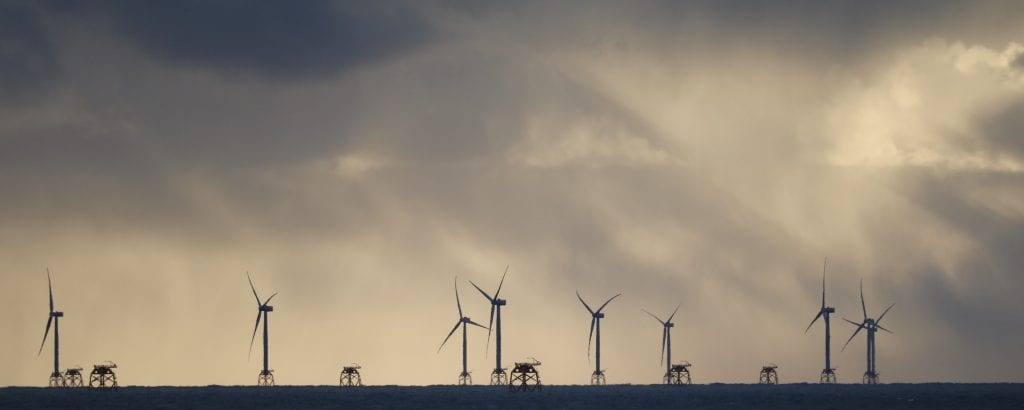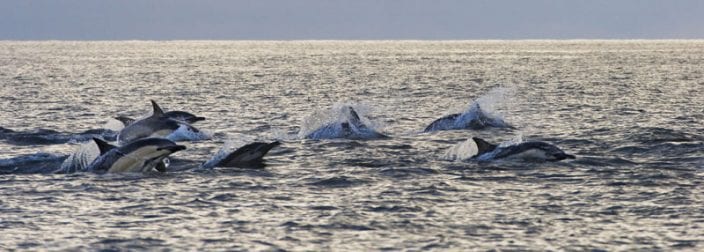Joint Oireachtas Committee on Climate Action
Tuesday 11th May 2021
Statement by Dr Simon Berrow, CEO of the Irish Whale and Dolphin Group and lecturer in Applied Freshwater and Marine Biology at the Galway-Mayo Institute of Technology
Renewable energy is a central pillar of Climate Action. The marine renewable energy industry in Ireland is expanding rapidly with a production target of 5GW of offshore wind energy by 2030 and an ambition of 30GW by 2050. Assuming a standard 7.5 MW turbine, up to 650 operational turbines may be deployed in the next decade or up to 4000 by 2050. Large sections of our coast will be transformed, impacting on our nearshore environment and coastal communities.
Offshore wind and marine renewables provides huge opportunities and challenges. We need to mitigate negative impacts on marine species and habitats, but we should also be looking for opportunities to enhance biodiversity, and contribute to ocean management.
The IWDG have worked on a number of offshore marine renewable projects, including at the SEAI Wave Energy Test Site off NW Mayo and commercial windfarm site surveys off the east and southeast coasts. We have prepared guidance documents for the SEAI[i] and in December 2020, we published a Policy Document on Offshore Windfarm Development[ii] to stimulate debate and present policy recommendations.
The marine renewables sector is operating within an environmental vacuum. There is very little guidance on environmental assessment, acceptable risk thresholds or monitoring requirements. A suite of baseline surveys are currently underway, including risk modelling and proposed mitigation. Some approaches are good, some not so good. Each company doing what they think is required to achieve planning consent. Tight environmental regulation enhances environmental protection, but also brings more certainty to an industry investing 100s of millions of euro. It’s good for everybody.
Potential impacts on some marine species are well understood (e.g. marine mammals and seabirds[iii],[iv]) but much less so for habitats, for example offshore sandbanks. But what are acceptable levels of habitat loss, noise exposure, collision risk or displacement?
Impacts are best mitigated by appropriate site selection, using best available data. Avoid those areas important for sensitive species and habitats. Current available data is poor and often out of date. Individual windfarm site surveys must be integrated into larger spatial scales and not evaluated in a piecemeal way through the planning process. There are good examples of state funded surveys (e.g ObSERVE[v] programme) aiming to address some knowledge gaps. Surveys should be ongoing, as marine distributions are influenced by climate change shifts.
Projects such as EirWind[vi] have provided guidance on supply chains and constraint mapping, but less on how to protect or enhance marine biodiversity and resources. A marine enhancement fund[vii] with contributions from industry, should be considered.
Industry need best practice guidelines, supported by legislation, to ensure site assessments and risk analysis are robust, appropriate and consistent. We can learn from countries in the southern North Sea and from the UK. The German approach is precautionary but quite prescriptive, setting thresholds for permitted noise generation and monitoring protocols. The UK take a more site specific risk-based approach. What best practices could work in Ireland, with our different marine environments and biodiversity?
The IWDG have recommended:
- data sharing agreements, to minimize duplication and disturbance.
- open-access online database for research and future development assessment
- an independent acoustic monitoring array to support monitoring and mitigation requirements
- adaptive management to respond to new opportunities or identified impacts
- an Integrated Ocean Management unit, with one regulator, responsible for marine environmental management as well as licensing
Offshore wind cannot be considered in isolation and needs to be integrated with fisheries management initiatives and MPA designation. The new Marine Planning and Development Management Bill could have addressed many of these issues, but there is deep concern amongst many groups whether it is currently adequate. Nevertheless, there is still an urgent need for contemporary data to support evidence-based policies.
Ireland has a poor track record of environmental monitoring and enforcement and strong policies, supported by legislation, is necessary to ensure offshore marine renewable energy is not at further cost to Ireland’s already depleted marine habitats and species.
Currently our relevant state agencies and departments are not resourced sufficiently to meet their obligations. Planning applications will soon be lodged for an array of windfarms along the east coast, followed by the Celtic Sea over the next few years. Windfarm development is currently industry led and government needs to catch up and take the lead through policy initiatives. Build a knowledge base for informed recommendations and policies.
Making decisions under time pressures and meeting renewable energy targets could lead to bad decisions, which we will have to live with for decades to come.
[i] https://www.gov.ie/en/publication/3d6efb-guidance-documents-for-offshore-renewable-energy-developers/
[ii] https://iwdg.ie/iwdg-publish-offshore-windfarm-policy-to-ensure-impacts-on-marine-mammals-are-kept-at-a-minimum
[iii] W. Hunt, M. Jessopp (2019). D4.13. Impacts from Offshore Wind Farms on Marine Mammals and Fish – A review of the current knowledge. http://doi.org/10.5281/zenodo.3948460
[iv] E. Critchley, M. Jessopp (2019). D4.12. Initial results for the assessment of seabird vulnerability to offshore wind farms in Ireland. http://doi.org/10.5281/zenodo.3948454
[v] https://www.gov.ie/en/publication/12374-observe-programme/
[vi] https://www.marei.ie/project/eirwind
[vii] https://www.nature.scot/funding-and-projects/scottish-marine-environmental-enhancement-fund-smeef
Further useful references
Wilson, J. and Elliott, M. (2009) The Habitat-creation Potential of Offshore Wind Farms. Wind Energy. 12. 203 – 212. 10.1002/we.324.
https://academic.oup.com/icesjms/article/63/5/775/661096
The marine renewables sector is operating within an environmental vacuum
“The marine renewables sector is operating within an environmental vacuum” said Dr Simon Berrow, CEO of the Irish Whale and Dolphin Group during his address today to the Joint Oireachtas Committee on Climate Action.
The IWDG were invited to contribute to todays session, which sought to explore the state of Ireland’s biodiversity, its relationship with climate mitigation and adaptation and the potential use for nature based solutions.
The IWDG have recently published a Policy Document on Offshore Windfarm Development (https://iwdg.ie/iwdg-publish-offshore-windfarm-policy-to-ensure-impacts-on-marine-mammals-are-kept-at-a-minimum) to stimulate debate and present policy recommendations. Chaired by Deputy Chris O’Sullivan the 2 hour session explored knowledge gaps, opportunities for biodiversity enhancement and sentinel species which can provide insights into the impacts of climate change.
Dr Berrow told the Committee “A suite of baseline surveys are currently being conducted by offshore windfarm companies, including risk modelling and proposed mitigation. Some approaches are good, some not so good with each company doing what they think is required to achieve planning consent“. He suggested that “windfarm development is currently industry led and government needs to catch up and take the lead through policy initiatives“.
What are acceptable levels of habitat loss, noise exposure, collision risk or displacement? Industry need best practice guidelines, supported by legislation, to ensure site assessments and risk analysis are robust, appropriate and consistent.
Tight environmental regulation enhances environmental protection, but also brings more certainty to an industry investing 100s of millions of euro. The IWDG have made a number of policy recommendations including:
- data sharing agreements, to minimize duplication and disturbance.
- open-access online database for research and future development assessment
- an independent acoustic monitoring array to support monitoring and mitigation requirements
- adaptive management to respond to new opportunities or identified impacts
- an Integrated Ocean Management unit, with one regulator, responsible for marine environmental management as well as licensing
Currently our relevant state agencies and departments are not resourced sufficiently to meet their obligations. Planning applications will soon be lodged for an array of windfarms along the east coast, followed by the Celtic Sea over the next few years. Build a knowledge base for informed recommendations and policies.
A marine enhancement fund, with contributions from industry, along the lines being currently piloted in Scotland (https://www.nature.scot/funding-and-projects/scottish-marine-environmental-enhancement-fund-smeef) should be considered. According to SMEEF the renewables industry has been a key support for the fund to this point and the majority of donations have been from them. It has allowed the post to be created and for development to begin in earnest.
Dr Berrow reminded the Committee that “the offshore marine renewable industry do not own the wind and waves, they are a community resource, but we require them to invest in the capabilities to harness their potential and provide benefits not only for industry and their shareholders, but for our coastal communities and the people of Ireland“.
The session is available to be watched online at https://twitter.com/i/broadcasts/1ypKdgvwjLoxW


